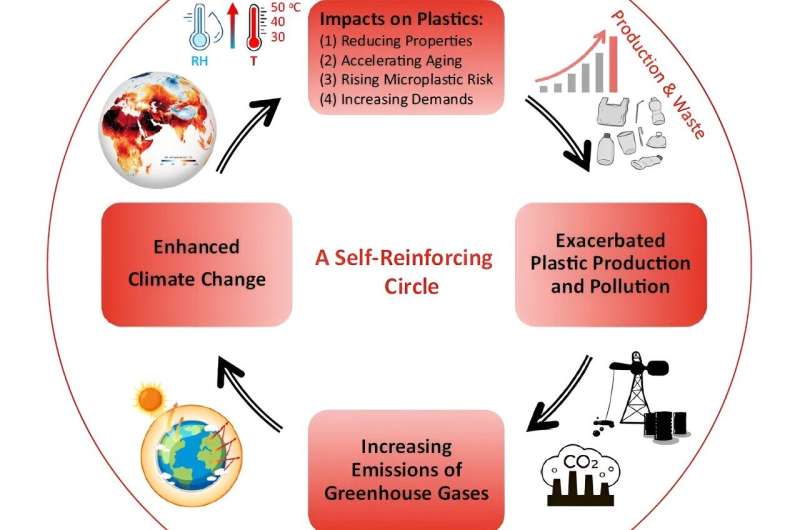This article has been reviewed according to Science X's editorial process and policies. Editors have highlighted the following attributes while ensuring the content's credibility:
fact-checked
peer-reviewed publication
trusted source
proofread
Global warming and plastic pollution entwined in vicious circle, researchers say

Typically viewed as unrelated problems, global warming and plastic pollution are instead inextricably trapped in a "vicious circle" where one feeds the other, researchers in Sweden report in Nature Communications. The mutually-reinforcing relationship escalates global warming, the degradation of materials, plastic waste and the leaching of toxic chemicals into the biosphere.
Plastics that we rely on every day will deteriorate more rapidly because of rising global temperatures, and one effect will be a demand for more plastics. Xinfeng Wei, a researcher in polymeric materials at KTH Royal Institute of Technology in Stockholm, says meeting that demand will further compound greenhouse emissions that drive up the global temperature.
"A self-reinforcing cycle is formed, creating a vicious circle between climate change and plastic pollution," Wei says.
In 2019, plastics generated 3.4% of global greenhouse gas emissions, or about 1.8 billion tons, mostly on account of their production and conversion from fossil fuels, according to the Organization for Economic Co-operation and Development (OECD). By 2060 that amount is expected to more than double.
The researchers describe a feedback loop linking these emissions with heat, moisture and the weakening structural bonds that lend a wide range of advantageous properties to polymers, the term for materials—like plastic and rubber—that are formed from long chains of large molecules.
"The higher the increase in temperature, the more the materials' properties are compromised," Wei says. The stiffness of commonly used plastics like polyethylene, polypropylene and polyvinyl chloride decreases by more than 20% as temperatures climb between 23°C and 40°C, he says.
This deterioration means more frequent replacement of polymer products—everything from clothing to auto parts and appliances—and consequently greater manufacturing volumes and rates.
Knock-on effects range from rendering food packaging unreliable to the fouling of waterways and fish habitats by an increase in microplastics, he says.
The report also documents the release of volatile organic compounds (VOCs) in a warming climate as well as other hazardous compounds including lubricants, flame retardants, plasticizers, antioxidants, colorants and UV/heat stabilizers. Heat will accelerate diffusion, evaporation and leaching of these substances into the air, soil, and water, the report says.
The researchers draw attention to the combined effects of heat and moisture, which rise together due to global warming. "A warmer atmosphere increases the evaporation of moisture and can also hold more water vapor," Wei says.
That's bad news for many materials, but it wreaks particular havoc on plastics when combined with heat. "The combined effects of rising temperature and moisture create very challenging conditions for these polymers," Wei says.
To tackle the challenge of plastic pollution and climate change, Wei and the co-authors urged attention and mobilization of efforts across all sectors involved in the plastic life cycle.
More information: Xin-Feng Wei et al, Plastic pollution amplified by a warming climate, Nature Communications (2024). DOI: 10.1038/s41467-024-46127-9
Journal information: Nature Communications
Provided by KTH Royal Institute of Technology





















